Enterprise management gives you the tools and processes to organize, control, and optimize every part of your business. You gain the ability to boost efficiency, streamline management, and stay competitive. Modern enterprise systems use AI to analyze huge data sets, automate routine tasks, and reveal insights that help you make better decisions. Many organizations now report that improved decision-making, higher productivity, and stronger security come from enterprise management systems. These tools transform your enterprise data into a dynamic asset that drives business success.
Enterprise Management Overview

What Is Enterprise Management
You manage your enterprise by bringing together people, processes, and technology to achieve your goals. Enterprise management gives you a structured way to organize, control, and optimize all business resources. You use enterprise management to align your daily operations with your long-term vision. This approach covers everything from strategic planning and resource allocation to performance monitoring and risk control.
When you implement enterprise management, you rely on enterprise systems to connect departments, automate workflows, and centralize data. These systems help you break down silos and ensure that everyone works toward the same objectives. You gain the ability to monitor progress, adjust strategies, and respond quickly to changes in the market. Enterprise management transforms your business into a well-coordinated, agile organization.
Key Principles
You succeed with enterprise management when you follow a set of proven principles. These principles guide your actions and help you build a strong foundation for growth.
- Strategic Planning: You set clear goals and map out the steps needed to reach them. Strategic planning ensures that every part of your enterprise moves in the same direction.
- Leadership and Culture: You foster a culture of commitment, innovation, and teamwork. Strong leadership and a shared sense of purpose drive your enterprise forward.
- Customer Orientation: You put your customers at the center of every decision. This focus helps you deliver value and build lasting relationships.
- Continuous Improvement: You encourage your team to seek better ways of working. Small, ongoing changes add up to big results over time.
- Operational Efficiency: You streamline processes and eliminate waste. Efficient operations free up resources for growth and innovation.
- Alignment and Adaptability: You align your structure, processes, and culture with your strategic goals. You also stay flexible so you can adapt to new challenges.
Note: Leading business consultancies recommend these principles because they support sustainable change and drive transformation. They highlight the importance of leadership clarity, customer-centricity, and a culture that embraces continuous improvement. When you embed these values in your enterprise, you create the energy and motivation needed for lasting success.
Organizational culture plays a critical role in adopting enterprise management practices. When you build a culture of commitment, teamwork, and innovation, you make it easier to implement new systems and processes. A supportive culture helps your team embrace change and work together toward common goals.
Modern Business Needs
Today’s business environment demands more from you than ever before. You face rapid technological change, global competition, and shifting customer expectations. To stay ahead, you need enterprise management that adapts to these challenges.
You use enterprise systems to integrate data, automate tasks, and provide real-time insights. These tools help you make faster, smarter decisions. Strategic planning becomes essential as you navigate uncertainty and set your enterprise on a path to growth.
Modern enterprise management gives you the flexibility to scale, the visibility to spot risks, and the agility to seize new opportunities. You can respond to market changes, manage complex supply chains, and deliver consistent value to your customers. By investing in enterprise management, you future-proof your business and position your enterprise for long-term success.
Why Enterprise Management Matters
Business Value
You want your business to grow and stay profitable. Enterprise management gives you the structure to achieve this. When you use enterprise management, you set clear goals, measure progress, and make changes based on real results. This approach helps you increase revenue, reduce costs, and improve customer satisfaction.
You can see how enterprise management creates value by looking at how goals and metrics work together. The table below shows how different aspects of management link to business value:
| Aspect | Description | Business Value Examples |
|---|---|---|
| Strategic Goals | Focus on outcomes for customers or beneficiaries, like improved satisfaction | Increased customer satisfaction and revenue growth |
| Intermediate Goals | Measurable milestones that support strategic goals | Progress toward revenue or cost reduction goals |
| Immediate Tactical Goals | Near-term actions to improve effectiveness or speed | Faster time-to-market, lower costs |
| Key Value Measures | Metrics that connect management to business value | Higher revenue per employee, lower product costs |
| Experimentation | Using experiments to validate and improve processes | Sustainable revenue growth, cost reduction |
You use enterprise management to align your team with your strategic planning. This ensures everyone works toward the same business goals. You track key value measures, like revenue per employee, to see if your management efforts pay off. When you experiment and adjust your approach, you find new ways to deliver value and keep your enterprise moving forward.
Tip: Regularly review your key value measures. This helps you spot trends and make better decisions for your business.
Competitive Advantage
In today’s fast-changing markets, you need more than just good products. You need enterprise management that helps you adapt quickly. Enterprise systems give you real-time data, automate tasks, and connect every part of your enterprise. With these tools, you can spot risks, respond to changes, and stay ahead of competitors.
Many industries have used enterprise management to overcome big challenges. For example, companies in manufacturing, technology, and retail have faced rising costs, new competitors, and changing customer needs. By using enterprise management and strategic planning, they have regained market share, improved efficiency, and boosted profits.
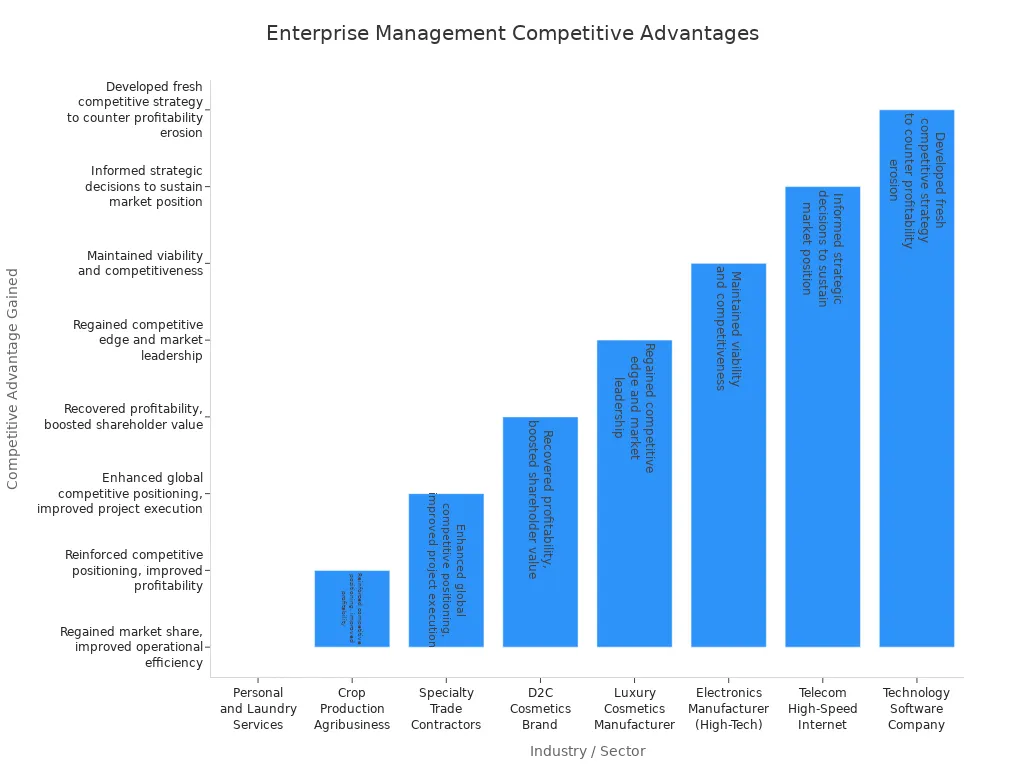
You can see from the chart that enterprise management actions—like adopting new technology, optimizing supply chains, and reassessing strategies—lead to real competitive advantages. When you use enterprise systems, you gain the agility to make quick decisions and the insight to plan for the future. This keeps your enterprise strong, even when the market changes.
FanRuan’s Role
You need the right tools to make enterprise management work. FanRuan provides advanced enterprise systems that support your management goals. With solutions like FineReport and FineDataLink, you can integrate data from every department, automate reporting, and visualize your business performance in real time.
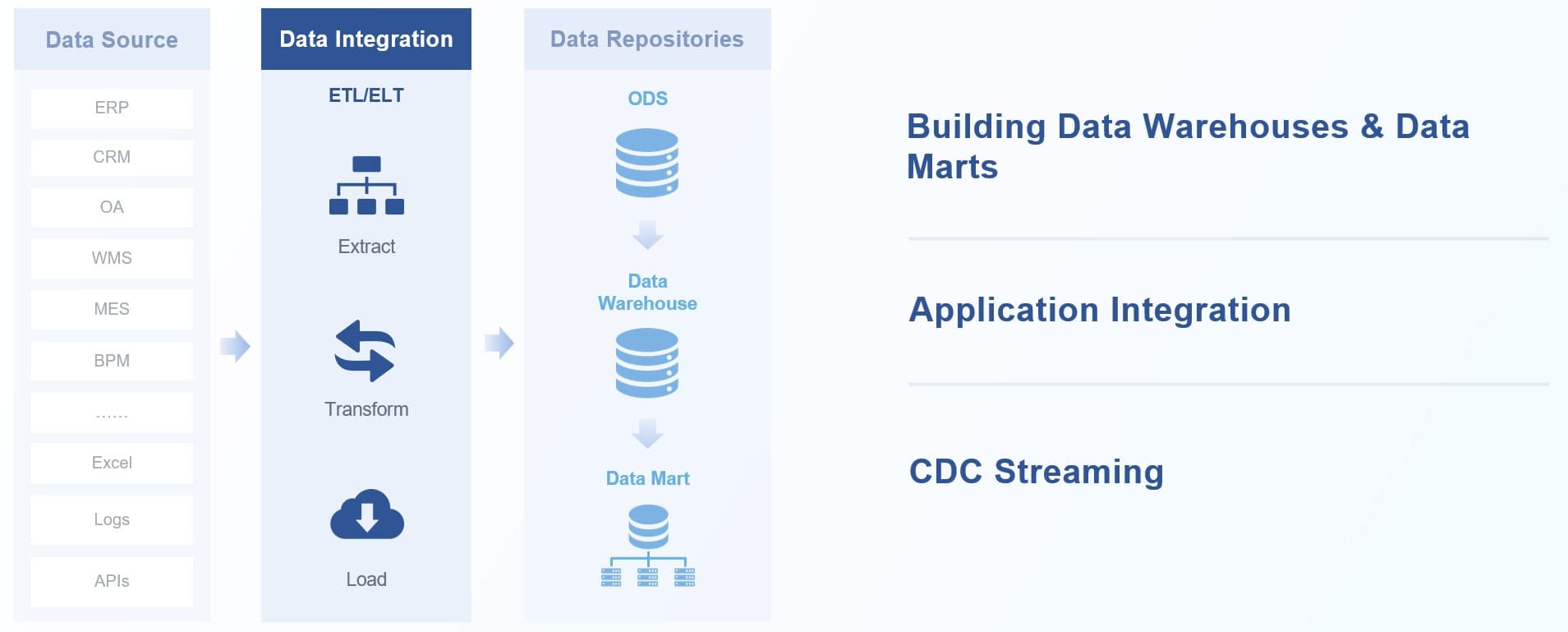
FanRuan’s enterprise systems help you with strategic planning by giving you accurate, up-to-date information. You can track key metrics, set alerts for risks, and create dashboards that show your progress. This makes it easier to align your management efforts with your business strategy.
When you use FanRuan’s tools, you empower your enterprise to make smarter decisions. You improve efficiency, reduce manual work, and foster a culture of continuous improvement. FanRuan’s commitment to innovation and customer success ensures that your enterprise management delivers real business value.
Enterprise Management Systems and Tools
Enterprise Systems
You rely on enterprise systems to manage your business operations. These large-scale software packages connect every department in your organization. You use them to automate tasks, store information, and support daily management. Enterprise systems include solutions like Enterprise Resource Planning (ERP), Customer Relationship Management (CRM), and Supply Chain Management (SCM). Each system helps you handle different parts of your business, from finance to sales to inventory.
When you use enterprise systems, you break down barriers between departments. You create a single source of truth for your data. This makes it easier to share information and work together. You also improve your management by tracking performance and spotting problems early. Large-scale software packages give you the tools to scale your business and adapt to new challenges.
Note: Enterprise systems form the backbone of modern enterprise management. They help you align your strategy, operations, and people for better results.
Data Integration Platforms
You need accurate and accessible information to make smart decisions. Data integration platforms help you achieve this by bringing together data from many sources into one unified system. These platforms eliminate data silos and ensure your information is clean, consistent, and reliable. When you use a data integration platform, you reduce errors and improve the quality of your business data.
For example, you might have sales data in one system and customer feedback in another. A data integration platform combines this information, so you get a complete view of your business. You can access real-time data and generate reports quickly. This supports faster analysis and better management decisions.
You also improve collaboration across teams. When everyone has access to the same data, you work together more effectively. You respond to changes faster and keep your enterprise moving forward. Data integration platforms standardize and automate data flows, making your management more efficient.
FineReport for Reporting
You need clear, timely reports to guide your management decisions. FineReport gives you a powerful reporting tool that connects to your enterprise systems and data integration platforms. With FineReport, you create dynamic dashboards and detailed reports without complex coding. You visualize key metrics and track your progress in real time.
FineReport supports a wide range of report types, from simple tables to interactive dashboards. You can customize reports for different users, such as executives, managers, or frontline staff. The software automates report generation and distribution, saving you time and reducing manual work.
You also benefit from FineReport’s ability to handle large data sets and integrate with multiple data sources. This flexibility ensures your management team always has the information needed to make informed decisions. FineReport helps you turn raw data into actionable insights, supporting every level of enterprise management.
Real-Time Analytics
You need to make decisions quickly in today’s business world. Real-time analytics gives you the power to see what is happening in your enterprise as it unfolds. You can monitor operations, track performance, and respond to changes without delay. This capability transforms how you manage your business.
When you use enterprise systems, you gain access to live data from every department. You do not have to wait for end-of-day reports or manual updates. Instead, you see sales numbers, inventory levels, and customer feedback as they happen. This immediate visibility helps you spot trends, identify risks, and seize new opportunities.
Real-time analytics supports proactive management. You can set up alerts for key metrics. If something unusual occurs, you receive a notification right away. For example, FineReport’s data alert plugin can be used to monitor enterprise-level key indicators, which is an important part of enterprise management. It can create alerts for various business data of the enterprise, timely obtain risk information during the enterprise's operational process, and notify the leading personnel, responsible departments, and corresponding regional users.
You also improve collaboration with real-time analytics. Teams across your organization can access the same up-to-date information. This shared view reduces confusion and speeds up decision-making. You avoid bottlenecks because everyone works from the same data. Enterprise systems make this possible by integrating data from multiple sources and delivering it in real time.
FanRuan provides advanced tools for real-time analytics. FineReport allows you to build interactive dashboards that update automatically. You can drill down into details, filter results, and visualize trends with just a few clicks. FineDataLink ensures that your data stays synchronized across all systems, so you always work with the latest information.
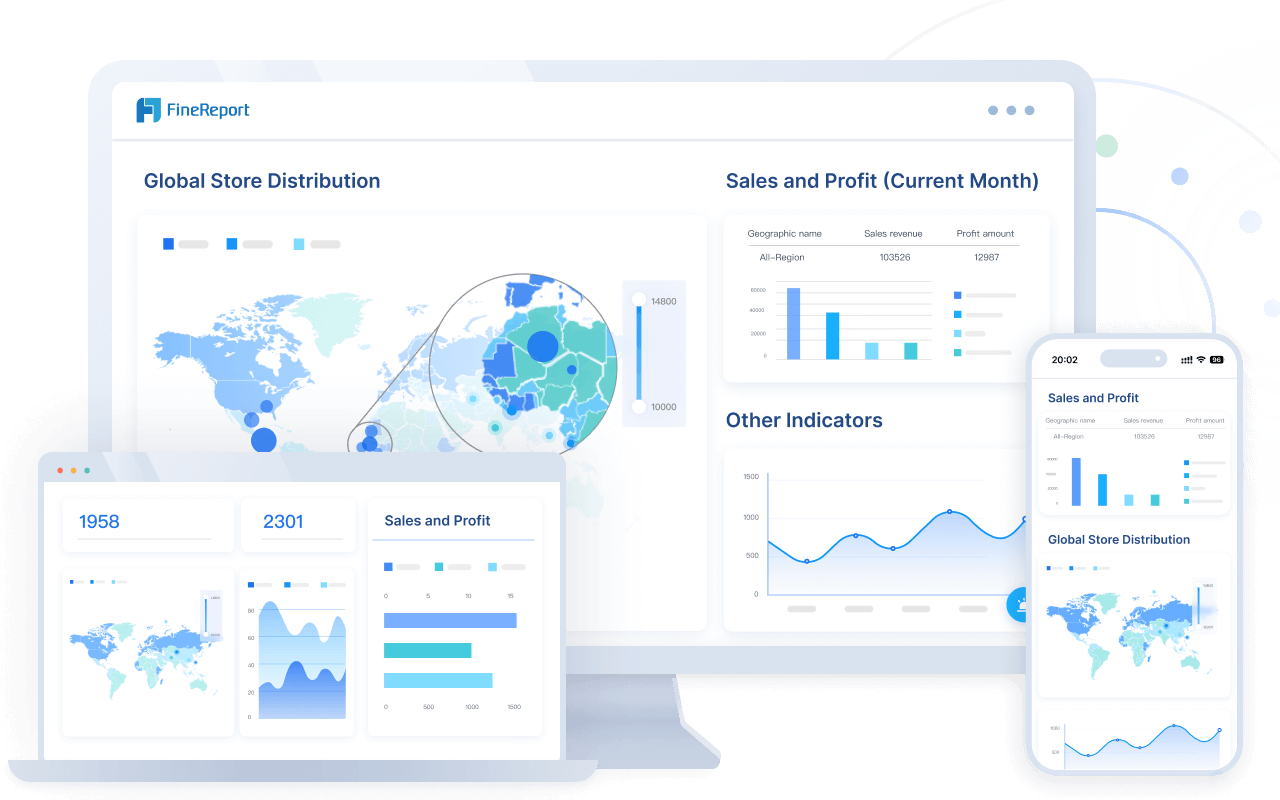
Here are some benefits you gain from real-time analytics in enterprise systems:
- Faster response to market changes
- Early detection of problems or risks
- Better resource allocation
- Improved customer satisfaction
- Enhanced operational efficiency
Tip: Use real-time dashboards to monitor your most important metrics. This habit helps you stay ahead of issues and make informed decisions every day.
You can see how real-time analytics, powered by enterprise systems, gives you a competitive edge. You become more agile, more informed, and better prepared for whatever comes next.
Benefits of Enterprise Management
Efficiency Gains
You want your enterprise to run smoothly and achieve more with less effort. Enterprise management gives you the structure to reach higher levels of operational efficiency. When you use management systems, you automate repetitive tasks and reduce manual errors. This approach saves time and lets your team focus on activities that drive business growth.
You can see operational efficiency improve when you standardize processes. For example, you might use enterprise management tools to streamline inventory tracking or automate payroll. These changes help you cut costs and speed up your workflows. You also gain better visibility into your operations, which means you can spot bottlenecks and fix them quickly.
Tip: Regularly review your processes and look for steps you can automate. Even small changes can lead to improved efficiency across your enterprise.
Better Decisions
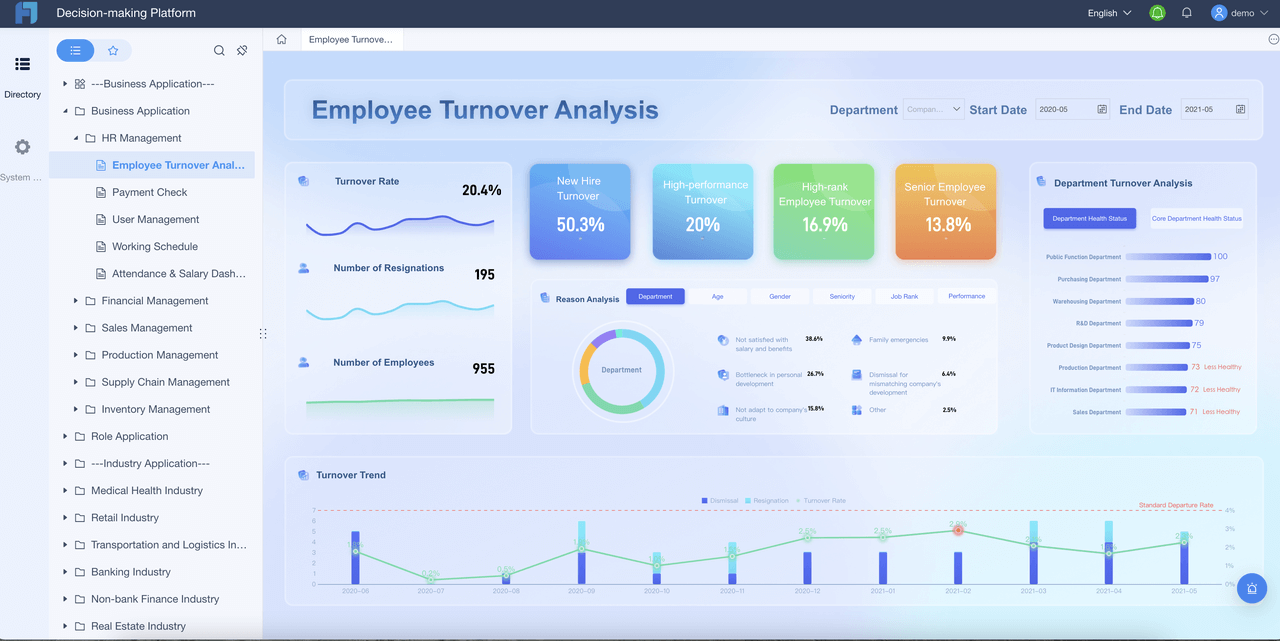
You make better decisions when you have access to accurate and timely information. Enterprise management systems collect data from every part of your business. You can analyze this data to understand trends, measure performance, and predict future outcomes. This data-driven approach supports improved decision-making at every level of your enterprise.
When you use management dashboards, you see key metrics in real time. You do not have to wait for monthly reports or guess what is happening. Instead, you act quickly and confidently. For example, if sales drop in one region, you can respond right away. This agility helps your business stay competitive and adapt to changes in the market.
A table can help you visualize how enterprise management supports better decisions:
| Management Tool | Decision Support Provided |
|---|---|
| Dashboards | Real-time performance tracking |
| Data Alerts | Immediate risk notifications |
| Automated Reports | Consistent, up-to-date information |
Enhanced Collaboration
You achieve more when your teams work together. Enterprise management breaks down barriers between departments and encourages enhanced collaboration. When everyone uses the same management platform, you share information easily and avoid misunderstandings.
Operational efficiency improves when teams communicate clearly. For example, your sales and production teams can coordinate schedules using shared dashboards. This transparency reduces delays and helps your enterprise deliver better results to customers.
Note: Enhanced collaboration leads to faster problem-solving and more innovative solutions. You create a culture where everyone contributes to business success.
Enterprise management gives you the tools to connect people, processes, and technology. You build a stronger, more agile enterprise that can handle any challenge.
Risk Management
You face risks every day in your business. These risks can come from many sources, such as market changes, supply chain disruptions, or data breaches. Enterprise management gives you the structure and tools to handle these risks before they become major problems. You gain the ability to spot issues early, respond quickly, and protect your business from unexpected losses.
When you use enterprise management systems, you create a framework for risk control. You set up processes to identify threats, assess their impact, and decide how to respond. This approach helps you avoid surprises and keeps your business running smoothly. For example, you can use dashboards to monitor key indicators, such as inventory levels or financial performance. If something looks unusual, you receive an alert and can act right away.
FineReport’s data alert plugin makes risk management even easier. You set custom alerts for important metrics in your reports. When a value crosses a certain threshold, the system sends you a notification. You do not need to check every report manually. The plugin does the work for you, saving time and reducing the chance of missing a critical warning. This proactive approach helps you catch problems early and take action before they escalate.
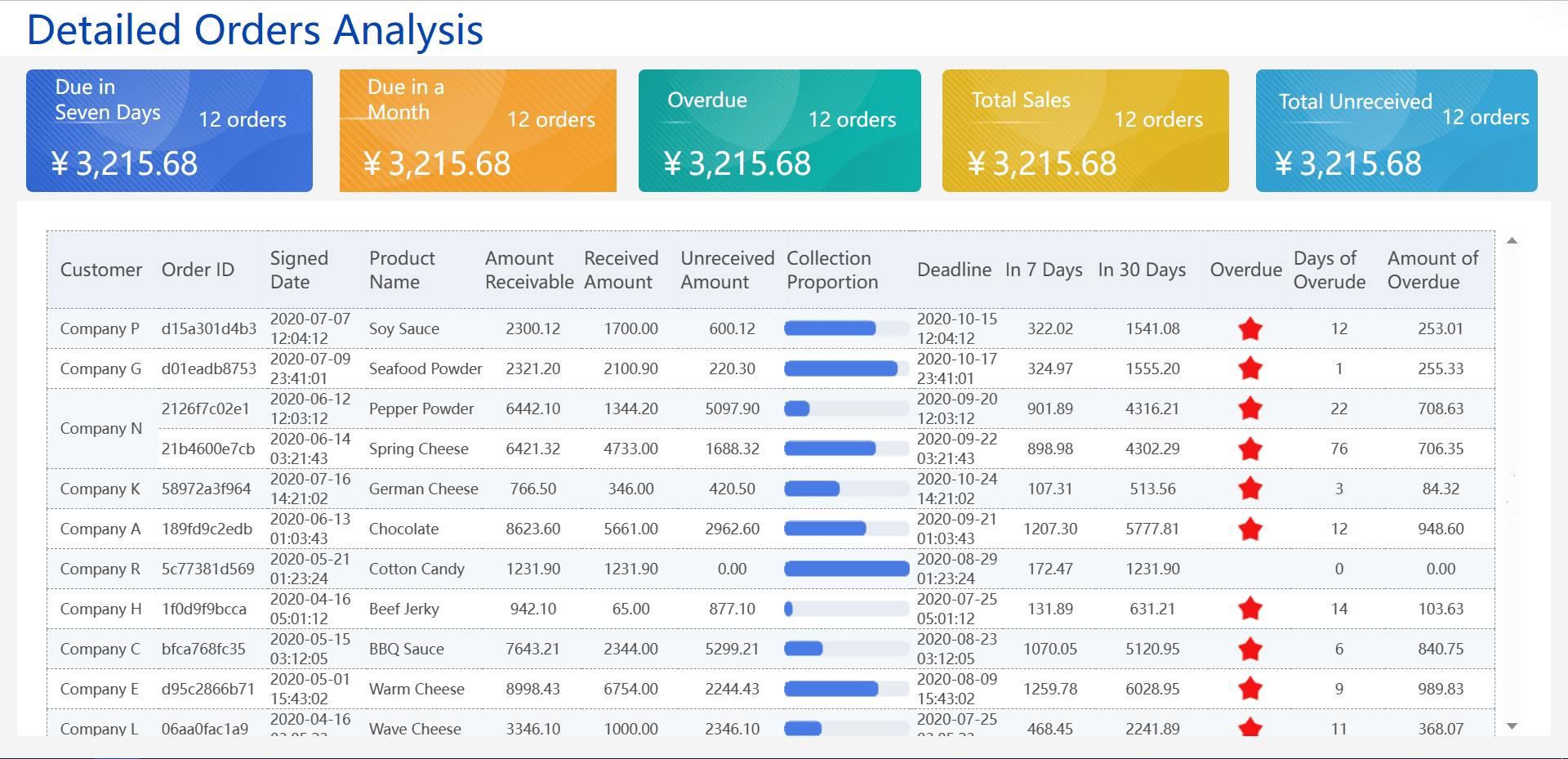
Tip: Set up alerts for your most important business indicators. This habit helps you stay ahead of risks and keeps your team informed.
You also improve compliance with regulations when you use enterprise management tools. You track changes in laws or industry standards and update your processes as needed. This reduces the risk of fines or legal issues. You keep detailed records of your actions, which makes audits easier and builds trust with stakeholders.
Here are some ways enterprise management supports risk management:
- Early Detection: You monitor real-time data and spot problems before they grow.
- Automated Alerts: You receive instant notifications for abnormal activity.
- Centralized Data: You keep all risk-related information in one place for easy access.
- Compliance Tracking: You stay up to date with rules and regulations.
- Incident Response: You follow clear steps to resolve issues quickly.
A simple table shows how enterprise management tools help you manage different types of risks:
| Risk Type | How Enterprise Management Helps |
|---|---|
| Operational Risks | Monitors processes and flags issues |
| Financial Risks | Tracks budgets and cash flow |
| Compliance Risks | Updates policies and records actions |
| Cybersecurity Risks | Alerts on suspicious system activity |
You build a safer, more resilient business when you make risk management part of your daily operations. Enterprise management gives you the confidence to face challenges and the tools to protect your future.
Implementation of Enterprise Management
Getting Started
You begin your enterprise management journey by setting clear goals and defining your vision. Start with strategic planning. Identify what you want your business to achieve and outline the steps to get there. Choose the right management systems that fit your needs. Look for solutions that connect your departments, automate tasks, and centralize your data.
Next, involve your team in the process. Assign roles and responsibilities so everyone knows their part. Train your staff on new management tools. FanRuan and FineReport offer user-friendly platforms that help you create reports, visualize data, and monitor progress. Use these tools to build dashboards and automate routine management tasks. This approach saves time and ensures everyone works with accurate information.
Tip: Start small. Focus on one area of your business, such as sales or inventory, and expand as your team gains confidence with the new management system.
Overcoming Challenges
You may face obstacles as you implement enterprise management. Common challenges include resistance to change, data silos, and lack of technical skills. To overcome these, communicate the benefits of management systems to your team. Show how these tools make daily tasks easier and improve business results.
Break down data silos by integrating all your information into one platform. FineReport and FineDataLink help you connect different data sources, making it easier to share information across departments. Provide ongoing training and support. Encourage your team to ask questions and share feedback. This creates a culture of continuous improvement and helps everyone adapt to new management processes.
Note: Change takes time. Celebrate small wins and recognize team members who embrace new management practices.
Measuring Success
You measure the success of your enterprise management initiatives by tracking key metrics. Focus on financial indicators like gross profit margin and return on investment. Monitor customer-focused metrics such as net promoter score, retention rates, and customer lifetime value. Operational metrics like productivity, product uptime, and employee satisfaction also provide valuable insights.
Use dashboards in FineReport to visualize these metrics. Set up automated reports to benchmark your progress and support data-driven decision-making. Regularly review your results and adjust your strategic planning as needed. This approach ensures your management efforts align with your business goals and drive continuous improvement.
A simple table can help you organize your key metrics:
| Metric Type | Example Metrics |
|---|---|
| Financial | Gross Profit Margin, ROI |
| Customer | Net Promoter Score, Retention |
| Operational | Productivity, Uptime, Satisfaction |
By measuring your progress, you connect your management strategies to real business outcomes. This helps you make informed decisions and achieve lasting success.
Enterprise Management Solutions with FineReport
Operation Warning Dashboard
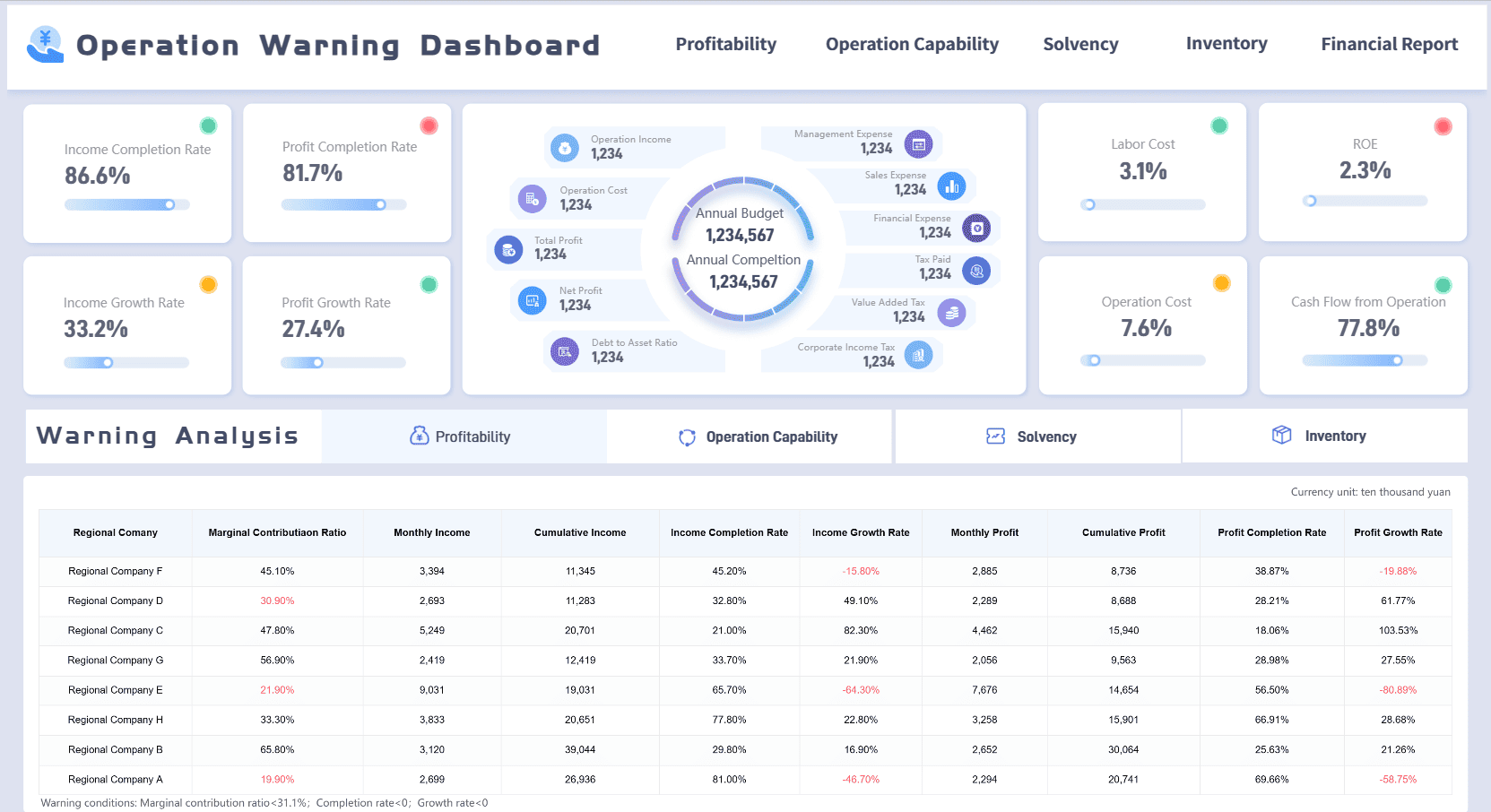
You need to spot problems before they disrupt your business. FineReport’s Operation Warning Dashboard gives you this power. You see real-time alerts for key metrics across your operations. The dashboard tracks data from every department and highlights unusual trends or risks. You do not have to search for issues. The system brings them to your attention right away.
You can set up custom warning rules for different business scenarios. For example, you might want to know if inventory drops below a certain level or if sales orders spike unexpectedly. FineReport lets you define these thresholds with just a few clicks. When the system detects an abnormal value, it sends you an alert. You receive notifications by email, SMS, or even through your mobile app.
Tip: Use the Operation Warning Dashboard to monitor production, sales, finance, and logistics. This approach helps you act quickly and prevent small issues from becoming big problems.
The dashboard also supports visual analysis. You see color-coded charts and graphs that make it easy to spot risks. You can drill down into the data for more details. This feature helps you understand the root cause of each warning and decide what action to take. FineReport’s Data Alert plugin makes this process even smoother by automating alerts and reducing manual checks.
Time Consuming Management
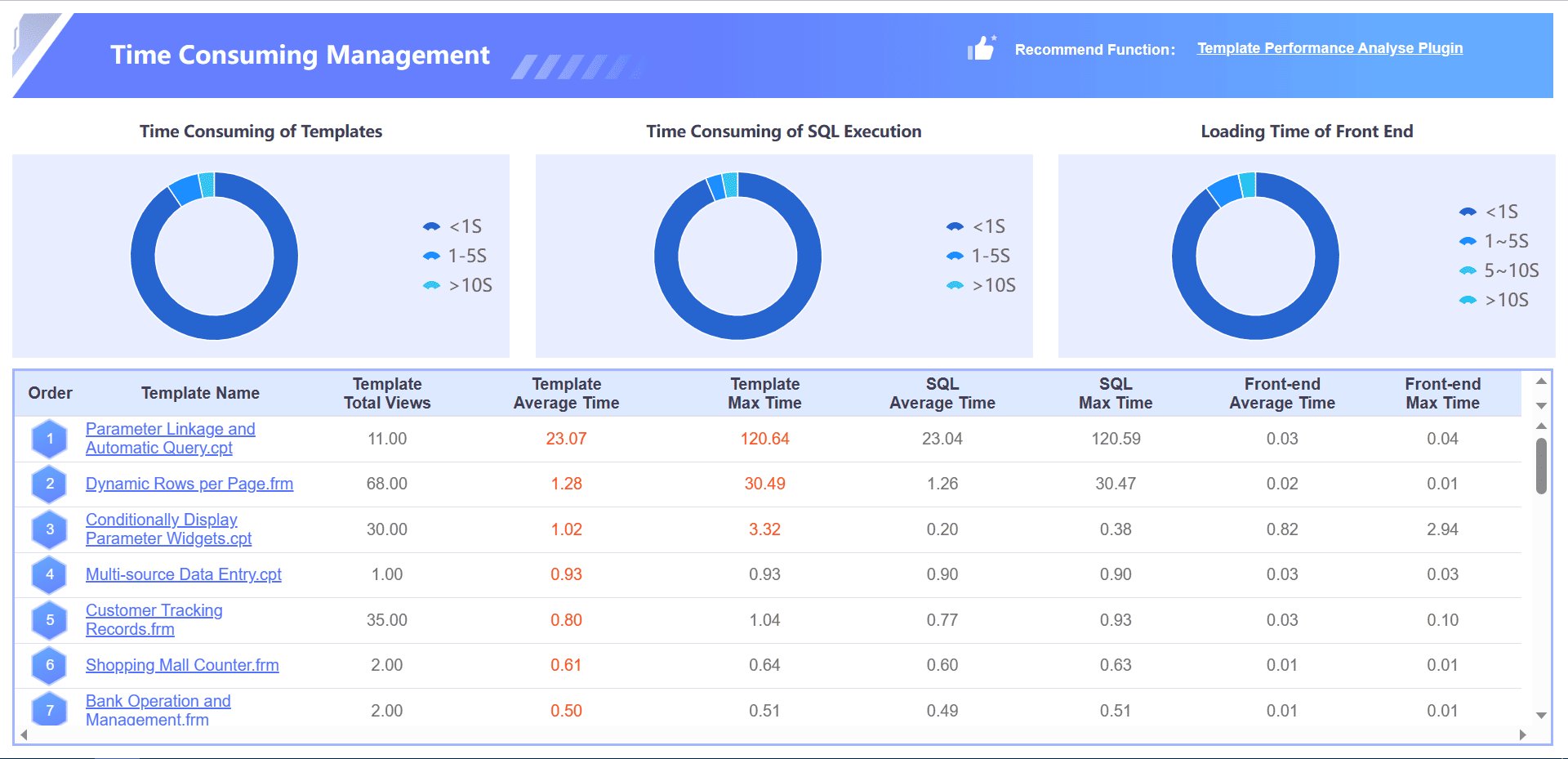
You want to know where your team spends the most time. The Time Consuming Dashboard in FineReport gives you a clear view of time usage across your business processes. You track how long each task or workflow takes, from order processing to equipment maintenance. This insight helps you find bottlenecks and improve efficiency.
FineReport collects time data from your systems and displays it in easy-to-read charts. You see which steps take the longest and which teams face delays. The dashboard highlights areas where you can save time or reassign resources. You do not need to guess where problems hide. The data shows you exactly where to focus.
Here is a simple table you might see on your dashboard:
| Task | Average Time (hours) | Status |
|---|---|---|
| Order Processing | 2.5 | On Track |
| Equipment Repair | 5.0 | Delayed |
| Inventory Check | 1.2 | On Track |
| Report Generation | 3.0 | Needs Review |
You use this information to set new goals and track improvements. When you reduce time spent on routine tasks, you free up your team for higher-value work. FineReport’s Time Consuming Dashboard helps you build a more productive and agile enterprise.
Note: Review your dashboard regularly. Small changes in process time can lead to big gains in efficiency and customer satisfaction.
Enterprise management gives you the structure to drive growth and efficiency in your business. You gain better control, faster decision-making, and stronger risk management. Integrated solutions like FanRuan and FineReport help you turn data into action. Review your current management systems. Identify areas for improvement. Explore new tools that support your goals. For more insights, visit FanRuan’s website or connect with industry experts.
Click the banner below to try FineReport for free and empower your enterprise to transform data into productivity!
Continue Reading About Enterprise Management
FAQ

The Author
Lewis
Senior Data Analyst at FanRuan
Related Articles

What is a data management platform in 2025
A data management platform in 2025 centralizes, organizes, and activates business data, enabling smarter decisions and real-time insights across industries.
Howard
Dec 22, 2025

Top 10 Database Management Tools for 2025
See the top 10 database management tools for 2025, comparing features, security, and scalability to help you choose the right solution for your business.
Howard
Dec 17, 2025

Best Data Lake Vendors For Enterprise Needs
Compare top data lake vendors for enterprise needs. See which platforms offer the best scalability, integration, and security for your business.
Howard
Dec 07, 2025




